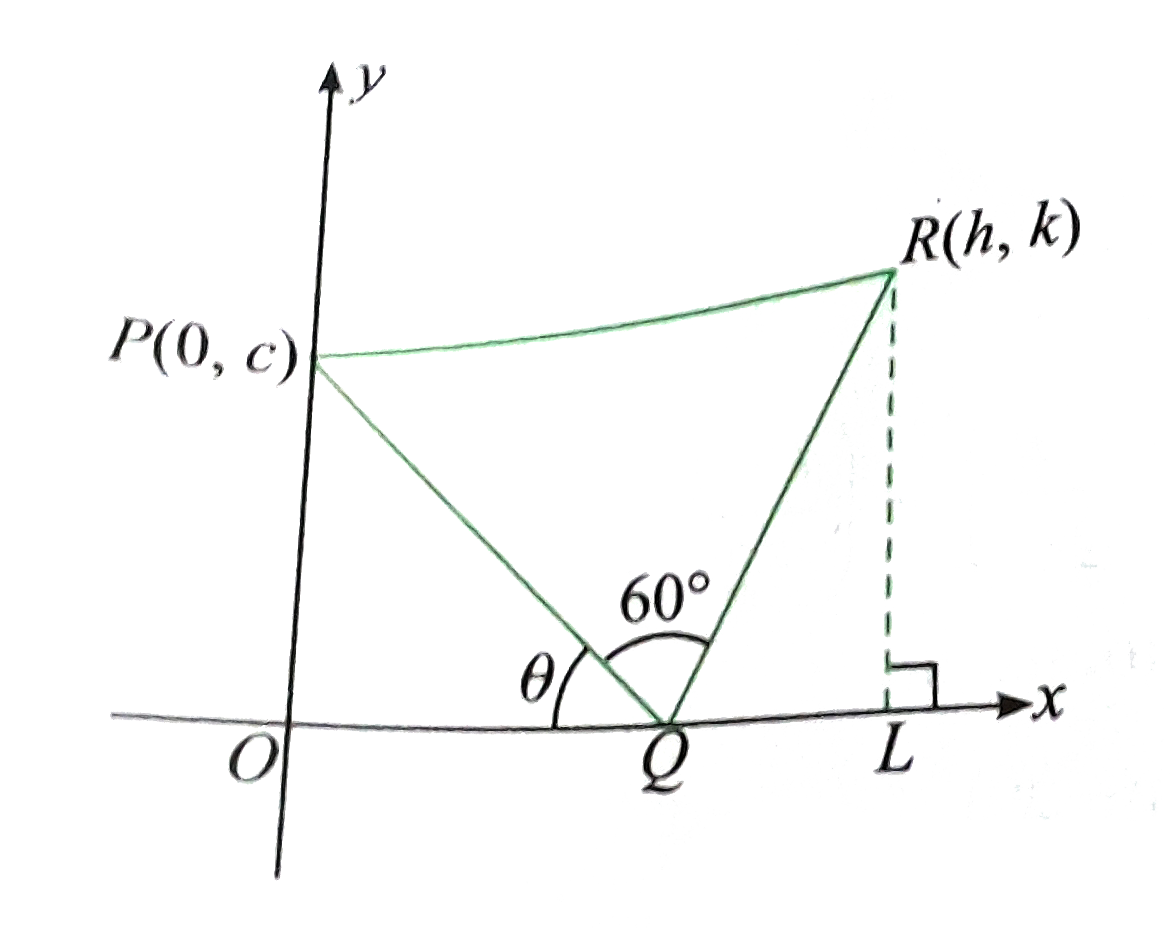OX and OY are two coordinate axes. On OY a fixed point P(0,c) is taken and on OX any point Q is taken. On PQ, an equilateral triangle is described, its vertex R being on the side of PQ away from O . Then prove that the locus of R is y=√3x−c
This given fixed point is P(0,c).
From given fig.,

h=OL=OQ+QL
=ccotθ+Qrcos(180∘−60∘−θ)
=ccotθ+PQ{cos120∘.cosθ+sin120∘.sinθ}
=ccotθ−PQ2cosθ+√32PQsinθ
=otθ−12ccosecθcosθ+√32ccosecθsinθ [∵sinθ=cPQ]
∴h=c2(cotθ+√3)(1)
Now, k=RL=RQsin(180∘−60∘−θ)
=PQ{sinθ×12+cosθ×√32}
=ccosecθ{12+sinθ×√32cosθ}
∴ k=c2(1+√3cotθ)
Eliminating cotθ from (1) and (2) , we get k=√3h−c.
Therefore the required locus is y=√3x−c, a straight line.
Topper's Solved these Questions
- COORDINATE SYSYEM BOOK - CENGAGE ENGLISHCHAPTER - COORDINATE SYSYEM EXERCISE - Concept applications 1.1
6 Videos
- COORDINATE SYSYEM BOOK - CENGAGE ENGLISHCHAPTER - COORDINATE SYSYEM EXERCISE - Concept applications 1.2
8 Videos
- COORDINATE SYSYEM BOOK - CENGAGE ENGLISHCHAPTER - COORDINATE SYSYEM EXERCISE - Illustration1.67
1 Videos
- COORDINATE SYSTEMBOOK - CENGAGE ENGLISHCHAPTER - COORDINATE SYSTEMEXERCISE - Multiple Correct Answers Type
2 Videos
- CROSS PRODUCTS BOOK - CENGAGE ENGLISHCHAPTER - CROSS PRODUCTS EXERCISE - DPP 2.2
13 Videos
Similar Questions
Let P is a point on the line y+2x=2 and Q and R are two points on the line 3y+6x=3. If the triangle PQR is an equilateral triangle, then its area (in sq. units) is equal to
View SolutionA variable straight line is drawn from a fixed point O meeting a fixed circle in P and point Q is taken on this line such that OP.OQ is constant ,then locus of Q is
View SolutionA straight line is drawn from a fixed point O meeting a fixed straight line in P. A point Q is taken on the line OP such that OP.OQ is constant. Show that the locus of Q is a circle.
View SolutionA straight lien is drawn from a fixed point O metting a fixed straight line P. A point Q is taken on the line OP such that OP.OQ is constant. Show that the locus of Q is a circle.
View SolutionIf P is any point on the plane lx+my+nz=pandQ is a point on the line OP such that OP.OQ=p2 , then find the locus of the point Q.
View SolutionIf PQ is a double ordinate of the hyperbola x2a2−y2b2=1 such that OPQ is an equilateral triangle, O being the center of the hyperbola, then find the range of the eccentricity e of the hyperbola.
View SolutionIf PQ is a double ordinate of the hyperbola x2a2−y2b2=1 such that OPQ is an equilateral triangle, O being the center of the hyperbola, then find the range of the eccentricity e of the hyperbola.
View SolutionThe coordinates of the point P are (−3, 2) . Find the coordinates of the point Q which lies on the line joining P and origin such that OP=OQ .
View SolutionP is a point on the line y+2x=1, and Q and R are two points on the line 3y+6x=6 such that triangle PQR is an equilateral triangle. The length of the side of the triangle is (a)2√5 (b) 3√5 (c) 4√5 (d) none of these
View SolutionIf P is any point on the plane lx+my+nz=pandQ is a point on the line OP such that OP.OQ=p2 , then find the locus of the point Q.
View Solution
